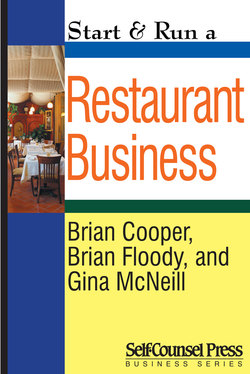Читать книгу Start & Run a Restaurant Business - Brian Cooper - Страница 19
На сайте Литреса книга снята с продажи.
1. The Business Plan: An overview
ОглавлениеThe business plan is a formal written presentation of your restaurant concept. It is used to introduce your business to potential lenders and should contain enough information for the reader (the investor) to judge the venture’s potential profitability. A business plan is a requirement if you are seeking a loan from financial institutions or trying to get “F & F” (family and friends’) funds. It is also the blueprint of your business dream and will serve as a guide during your business’s lifetime.
A well-researched and properly documented plan is a prerequisite to a successful business and should be professionally presented. You can gather the material yourself and have it spiral bound at a print store, or you can hire a consulting firm that specializes in the hospitality industry to conduct the feasibility study for you and then assist you in writing the business plan. Depending on your writing experience and financial-planning and research background — as well as your time limitations — it may be worthwhile to contract out this work. Whatever you choose, the plan must portray your ideas and passions and must communicate these to the lenders. If this is your first time approaching a lender for a small-business loan, it often helps to have the name of a reputable accounting or consulting firm attached to your proposal. They may already have established relationships with banks, which may help convince the lender of your ability to meet the loan obligations. Bankers are not experts in the hospitality field, but they are very aware of the high restaurant-fatality rate, and therefore often look to “experts” for their approval of a particular plan.
The essential parts of the business plan are as follows:
(a) Cover page and index.
(b) Statement of objective. If you are seeking money, state how much you need and other pertinent details.
(c) Executive summary. This is a brief synopsis of the company or partnership, and a description of the proposed restaurant, including:
(i) Its name, address, phone number, and website address, and any graphics that have been developed (i.e., logo or signage designs).
(ii) A description of the type and style of your proposed restaurant (e.g., fine dining, bistro, pub, casual dining). Summarize the overall concept as well as the kind of food, décor, and service style. A menu can be inserted here as well as an artist’s rendering of the dining room, color scheme, and description of furniture and fixtures as they support your concept.
(iii) Location. Describe the proposed site and why it was selected, as well as its access to major routes and other demand generators.
(iv) Customer profile and target market. Describe the demographic characteristics of your customers. (You can use information from the feasibility study in section 2. for this.)
(v) Your competition. Describe your competition, then focus on what makes your restaurant unique and how it will fill a void in the marketplace. Discuss how you will compete with existing restaurants. (Once again, the research you do for your feasibility study will be used here.)
(vi) Marketing and advertising strategies. Include any promotional material you’ve developed.
(vii) Historical information on the business, if applicable.
(viii) Management team. Describe the experience, expertise, and ability of the team members (chef, dining-room manager, wine steward, and restaurant designer) and emphasize their achievements in the industry. Include information on successes the members of your team have had in running similar restaurants.
(ix) Ownership and business structure. Describe who will own what percentage of your enterprise, and indicate the business structure (see Chapter 2) under which you plan to operate.
(d) Financial projections and documents. These statements include your capital budget, projected income (or profit-and-loss) statement, your break-even analysis, projected balance sheet, and projected cash-flow analysis. (See Chapter 4 for a further description of financial statements.) These statements should be created by an outside accountant, bookkeeper, or CPA. Also include a summary of your financial needs: indicate why you are applying for a loan, how much is needed, how much your own investment in the restaurant will be, and any other sources of funding. Describe how the funds will be used, and include any back-up information regarding costs of equipment and furnishings.
(e) Supporting material to strengthen parts of your business plan. This should include any information you can supply that outlines your previous success or achievements, such as:
(i) Résumés and personal letters from noteworthy industry associates or leaders recommending you as a professional and good “risk,” as well as press clippings, editorials, testimonials, or awards that have been received by members of your team for outstanding achievement in the hospitality industry.
(ii) Copies of leases and agreements between you and landlords or equipment companies.
(iii) Credit reports from banks and any established credit from suppliers or wholesalers.
Make copies of your business plan for yourself and each lender you approach. Having the business plan spiral bound will give it a professional look and reflect your intent to create a profitable business. Keep track of who has copies of your business plan.
When it comes to acquiring your financing, be sure to allow enough lead time. It may take up to six months after your business plan has been presented to actually receive the funds.
For more information on business plans, Self-Counsel Press publishes many business forms and templates.
